There is a strange feeling that we are nearing home even though we are actually heading towards Denmark. There is something about the little red brick villages we have been passing through that remind us of Suffolk while the many shallow lakes and flat landscape are reminiscent of Norfolk with its Broads.
We left Potsdam just before midday and made our way north towards Hamburg. Jill was anxious to move on, aware that time is fast running out. In just five weeks we will need to be back in Exeter and we still have so much we hope to do. So we missed out the town of Brandenburg and have managed to avoid Hamburg and several smaller cities in order to move north as quickly as possible.
We have been amazed at just how empty the landscape is in Northern Germany. Most of our travels have been in the area of the former GDR where large collective farms were the norm. The legacy of this is still there with endless acres of cereals, ripe for harvesting, or huge fields of stubble that stretch as far as the eye can see across the empty landscape. It can easily be fifteen or twenty kilometres between villages and these seem to be little more than several farmsteads gathered together.
There is also much woodland. We seemed to pass for ever along die-straight roads through pine forests but with nowhere to pull off the road for a rest. Sometimes we would travel for several minutes without seeing another vehicle, and this on the main road linking Hamburg to Berlin!
At Wittenburg we stopped for fuel and to stock up on food as we had done no shopping during our visit to Berlin. We seem to have made good progress, the driving has been about the easiest we have done anywhere – the roads make rural France look busy! Soon we were passing into Schleswig-Holstein and back into the area that was always part of West Germany. It may be for this reason that fields here are smaller and there are fences and hedges. Certainly the landscape is more interesting and hospitable with horses in paddocks, cattle out in the fields, pretty little villages that are reminiscent of England built in red brick and tiles, sometimes using timber beam construction, little churches with wooden spires, weeping willow trees and pretty gardens.
Ian announced a sudden desire to visit Lübeck and as we do not wish to drive in the city we have found a campsite beside a lake on the edge of one of the little villages. It is peaceful and pretty here. Tonight Jill went for a swim and Ian for a paddle. In fact all we could do was paddle as no matter how far out we waded it never seemed to get much above our knees. A bit disappointing for Jill but it is certainly a very beautiful setting and ideal for shallow boats and canoes. It may be possible to cycle to the town of Ratzeburg tomorrow and take the train into Lübeck.
 Ratzeburger See Römnitz
Ratzeburger See RömnitzAs we sat by the lake this evening Ian mentioned places in the area he had visited in his youth when he was studying German. Jill had not realised he had ever visited this area before so it looks as if there may be a few more ghosts from the past to sort out before we return home. Ian's mum was a student of German in her youth and worked as a nanny to a German family right near the border with Denmark when she was a teenager in the late1920s. She remained in contact with the family and friends for many years much as Jill has done with her friends in the Jura. Contact was lost during the war but picked up again later. The result was that the next generation of young people made contact with each other and exchange visits were made. It is here therefore that Ian learned much of his German that later led to him studying it for his degree.
Ian's mum is no longer alive and links with the area have lapsed for some time. However, Ian is eager to see the region again and to perhaps recognise places he once knew well. It will provide an interesting purpose for exploring the area which shows every sign of being fascinating anyway.
Ian has just been checking the map – when isn't he? He has announced that we are as far north as Blackpool! That's a deal further north than we were in Tarifa!
Tuesday 25th July 2006, Römnitz near Ratzeburg, Schleswig-Holstein
Same place, different campsite. This morning we decided in view of the heat that it would be foolish to cycle eight kilometres to the railway station and still have any energy to explore Lübeck. So we packed up and left the campsite by the lake and drove to the railway station at Ratzeburg. It turned out to be right on the far side of the town which is on an island in the lake linked to the shore by a causeway. It would certainly not have been sensible to cycle there.
We left Modestine in the station car park and twenty minutes later were walking out of the main station onto the streets of Lübeck. It was love at first sight! We were both immediately captivated by the city with its gabled merchants' houses, enormous brick churches, tall green spires, tiny almshouses, beautiful little courtyards filled with roses and hollyhocks, cobbled streets and mediaeval gateways. The city is encircled by a wide canal with commercial and pleasure craft and of course has a huge port. The last two we have only glimpsed briefly but there was a tang of the sea in the air as we looked out towards the harbour. We have yet to see the sea but the air is fresher here and we have a yearning to once again be near to salt water. The last time we were on a beach was north of Ravenna on the Adriatic. How long ago that seems and how hot and airless it has been deep in the centre of Europe over the past few months.
It is still very hot. The liquid crystal thermometer displayed in the centre of Lübeck this afternoon registered 40 degrees. But at night here it seems much cooler than further south.
It is so very different here in Northern Germany. As the countryside and villages yesterday reminded us of England, so today Lübeck reminded us of Holland. It is a beautiful city getting on with its everyday life rather than a tourist showpiece. It has so many churches, museums, galleries and ancient commercial buildings it is impossible to do any sort of justice to them here. So below is a selection of photos to give an impression of what we saw today.
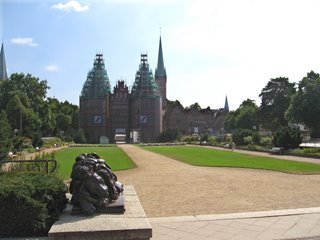 Holstentor under restoration, Lübeck
Holstentor under restoration, Lübeck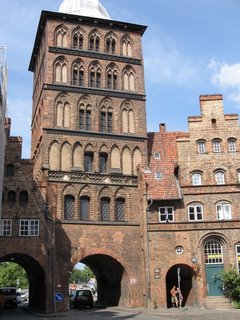 Burgtor, Lübeck
Burgtor, Lübeck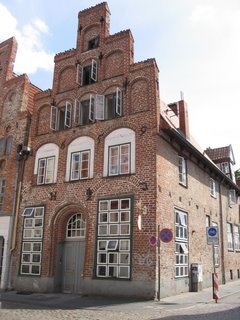 House in Rosengarten, Lübeck
House in Rosengarten, Lübeck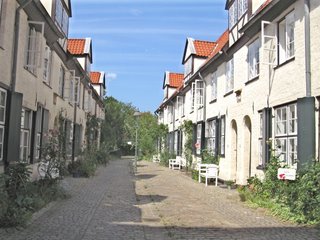 Glandorpsgang almshouses, Lübeck
Glandorpsgang almshouses, Lübeck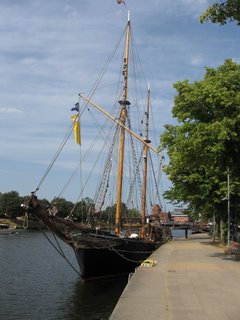 Historic port, Lübeck
Historic port, Lübeck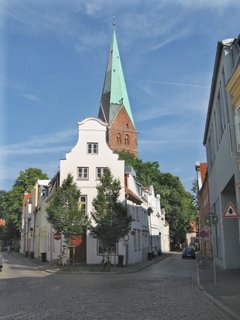 Street leading to St. Aegidien's Church, Lübeck
Street leading to St. Aegidien's Church, Lübeck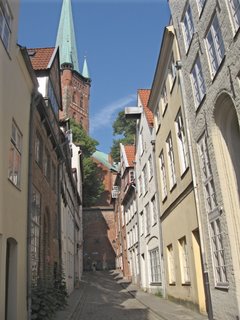 Grosse Petersgrube, Lübeck
Grosse Petersgrube, LübeckThe city was very badly bombed during the war, presumably because, like Kiel to the north, it was a port. The main raid took place on Palm Sunday 1942, shortly before Exeter was badly bombed in revenge. It is difficult, looking at the city today, to appreciate the state of damage after the war. There are many photos though, showing the damage before restoration. Frequently buildings have had to be almost completely rebuilt.
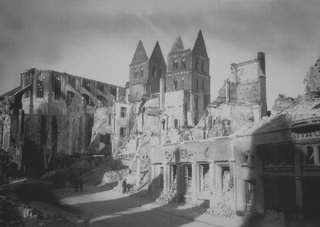 St. Mary's Church, Lübeck, 1942
St. Mary's Church, Lübeck, 1942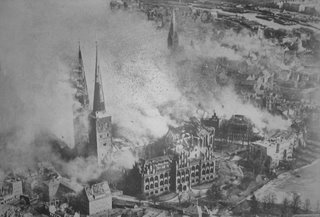 Cathedral, Lübeck, 1942
Cathedral, Lübeck, 1942We visited the church of St. Mary which is the tallest brick church in the world. Inside the area is vast with its huge gothic arches, stained glass windows and simple, clean lines, devoid of flamboyant decoration such as we have seen in the baroque churches around Vienna. Here the beauty is in the architecture, carrying the eye for ever upwards, rather than in ornamentation. There is an astronomical clock housed here.
 Friends reunited, outside St. Mary's Church, Lübeck
Friends reunited, outside St. Mary's Church, LübeckThe Devil reflects a legend connected with the building of the church
 Nave, St. Mary's Church, Lübeck
Nave, St. Mary's Church, Lübeck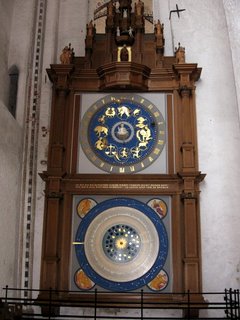 Astronomical clock, St. Mary's Church, Lübeck
Astronomical clock, St. Mary's Church, LübeckNext we went on a guided tour of the Rathaus or town hall. This is built using red fired bricks and others that had been glazed black to provide an interesting decorated exterior. Originally dating from mediaeval times it has been added to in the 19th century in similar style using machine manufactured bricks rather than hand-made ones.
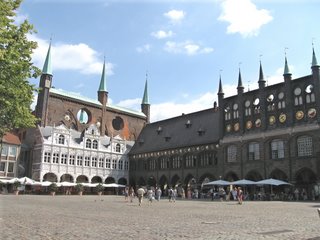 Town Hall from the Market Square, Lübeck
Town Hall from the Market Square, Lübeck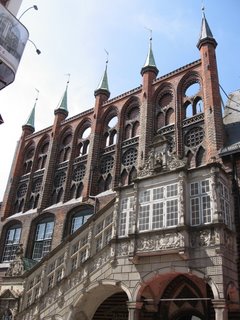 Town Hall from Breite Strasse, Lübeck
Town Hall from Breite Strasse, Lübeck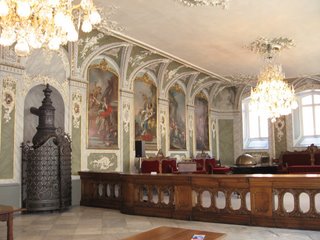 Audience room in the Town Hall, Lübeck
Audience room in the Town Hall, Lübeck Stairway with historic murals in the Town Hall, Lübeck
Stairway with historic murals in the Town Hall, Lübeck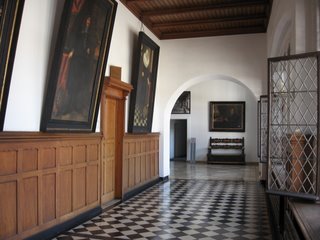 Corridor with mayoral portraits in the Town Hall, Lübeck
Corridor with mayoral portraits in the Town Hall, LübeckNot a Vermeer painting!
Worthy of special mention was the hospital where the elderly and infirm have been cared for and accommodated since the 13th century. It is still in use today. The main hall is decorated with 15th century frescos, carved screens and statues of the saints.
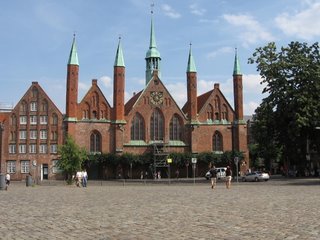 Heiligen Geist Hospital, Lübeck
Heiligen Geist Hospital, Lübeck Heiligen Geist Hospital, Lübeck
Heiligen Geist Hospital, LübeckGunter Grass, the noble prize winner for literature, is a son of the city. His home is now a museum. Although we knew of him as a writer we had not realised he was skilled as a painter and sculptor as well.
Also from Lübeck are the Mann brothers, Thomas and Heinrich, both writers. Their home is now a museum of their works and time. The house is known after the title of possibly Thomas Mann's most renowned novel, Buddenbrooks. Ian studied Mann at university and Jill confesses to trying to read it – in translation – years ago but found it too heavy going. Little could I have known that today I would be sitting drinking a beer at the bar just opposite the very house where it was both set and written! I'll have to have another attempt when we get home.
 Buddenbrooks House, Lübeck
Buddenbrooks House, LübeckWe'd been walking most of the day in great heat. Fortunately everything is close together in the old town and the rows of stunning, gabled houses either side of the cobbled streets are almost guaranteed to provide a little shade at any time, so it has not been as difficult as Dresden, Berlin or Vienna where each sight stands isolated in a furnace of sunlight. However, by the time we eventually sat down for a beer we found it hard to get going again. A cursory glance in at the cathedral on our way back towards the station was all we could manage. After the beautiful interior of St. Mary's church the cathedral seemed something of an afterthought being white painted brick inside. Like all the churches in Lübeck it is huge in scale and has some interesting monuments.
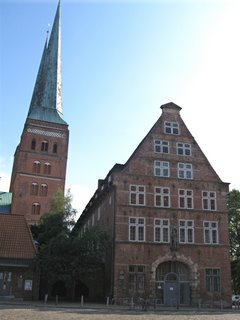 Cathedral with Zeughaus in front, Lübeck
Cathedral with Zeughaus in front, LübeckWe caught the train back to Ratzeburg and rejoined Modestine. We were not wildly enthusiastic about last night's campsite so decided to try the other one we'd seen a sign for. No campsites are perfect and each has its peculiarities. Prices seem much the same, around 16-19 euros in this area, 25 euros at Potsdam. Here facilities are a very long way in complete darkness from the camping area but at least hot water and showers are included. It is annoying to sometimes discover, as you rush to clean up after the heat of the day, that it costs an extra euro each for a three minute shower.
Wednesday 26th July 2006, Büsum, on the North Sea, Schleswig-Holstein
Our steady advance on Denmark continues as we travel northwards. The sun is travelling with us and is as unrelenting as ever. We decided to head for the North Sea hoping it would be fresher here than on the Baltic and also that there would be fewer summer visitors. Probably we have been correct on both counts. Certainly the roads have not been busy and generally this area of Germany seems very sparsely populated. There is also a slight breeze this evening up on top of the dyke that protects the coast from the winter gales – difficult to imagine under today's searing sunlight! Our miscalculation was to forget that being flat reclaimed polder lands with endless acres of cereals and herds of black and white Frisian cattle, there are very few trees and no welcome shade to relieve the eyes from the bright perpetual glare of the sun. Out in the midst of it all farmers are gathering in the harvest, making their way back and forth with their combine harvesters, lost amidst a choking cloud of dust.
Leaving the campsite this morning we parked in the attractive little town of Ratzeburg on its island in the lake in the vain hope of finding internet access. Ian went off to discover the cathedral which is brick built Romanesque, constructed in the 12th century and standing in a picturesque position amid greenery perched above the lake. Jill had too many blisters from wearing new sandals around Berlin and Lübeck to be enthusiastic about a walk around the cobbled streets, so contented herself with browsing the little shops of the town and watching people going about their daily business. It also provided the opportunity to add a new manhole cover to our growing collection!
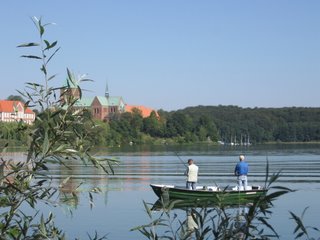 Cathedral seen across the lake, Ratzeburg
Cathedral seen across the lake, Ratzeburg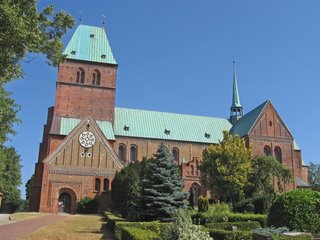 12th century cathedral, Ratzeburg
12th century cathedral, Ratzeburg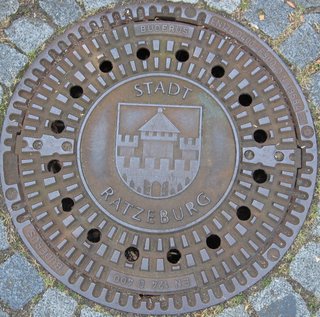 Manhole cover, Ratzeburg
Manhole cover, RatzeburgWe mentioned Ian had distant links with this area through his mother. Browsing the phonebook at the last campsite he discovered someone he met back in the 1960s listed and determined to revisit the tiny village of Tremsbüttel to see if he recognised anything. The village lies in a remote area of open countryside north of Hamburg. In the 1920s when Ian's mum was here it must have been a very lonely place indeed. As soon as we reached the village Ian recognised the house though many of the surrounding buildings were more recent.
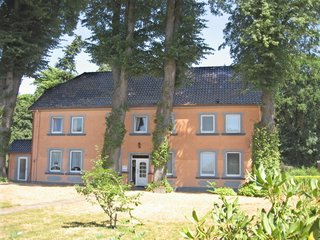 The former farmhouse where Ian stayed, Tremsbüttel
The former farmhouse where Ian stayed, TremsbüttelA very friendly lady answered Ian's knock at the door and didn't seem in the least phased by his strange tale. She called her father-in-law and he and Ian chatted about the family and what became of each member. Ian says he could immediately recognise the man he had known so long ago. Not so with him. He couldn't remember Ian at all, but then Ian was only about 15 at the time! We have learnt that his younger sister, who had stayed with Ian's family in England, now lives in Berlin, so there is no chance of meeting her as we have passed well away from that area now. There are other links further north from here so we will perhaps look in on the village of Niebüll near to where his mother lived for several months and where Ian spent several childhood holidays.
Having said goodbye and that we'd pop in again next time we were passing in another forty years we explored the pretty village with its thatched brick cottages, symmetrically laid out herb gardens, village pond and the castle. This is set in its own grounds and is now a privately run hotel. We walked into the gardens and up to the front door where a very nice young lady happy accepted Ian's statement that he was tracing his past and told us we could go inside and wander around. Apparently the place was being used today by North German Television who is making a melodrama with Dracula-type characters and the castle provides the perfect setting! We wandered from room to room, each furnished with huge dressers, tables, mirrors, vases and long case clocks. Go upstairs as well, we were told. On the wide staircase were two carved and painted angels beneath the large stained glass window and at the top a coat of armour. Pushing at a half open door we entered a room in deep shadow where the blinds had been drawn. Reflected in the mirror of the dressing table was the face of Dracula himself, grinning savagely as he checked that his fangs were sufficiently bloody for the forthcoming scene about to be shot! We had accidentally stumbled into his dressing and make-up room. We retreated hastily back downstairs and out through the main doors to the castle making good our escape before we got offered parts as extras in the production!
 Thatched brick cottage with herb garden, Tremsbüttel
Thatched brick cottage with herb garden, Tremsbüttel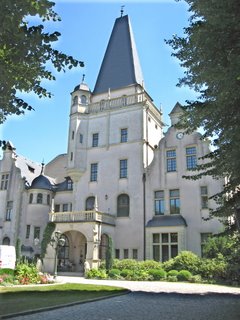 Castle, Tremsbüttel
Castle, Tremsbüttel Castle interior, Tremsbüttel
Castle interior, Tremsbüttel Castle interior, upstairs landing, Tremsbüttel
Castle interior, upstairs landing, TremsbüttelAfter a picnic by the pond we left Tremsbüttel and will almost certainly never return. Our visit had turned out to be far more interesting than we could possibly have imagined. Ian's greatest regret is that he cannot tell his mum about is. She would have been highly amused and delighted by the whole affair.
Temperatures rose well into the 30s this afternoon and we stopped at the town of Kaltenkirchen to cool off with ice creams. Towns are all small and many kilometres apart north of Hamburg and we have given up trying to find internet access for the time being. Realising that any campsites would be on the coast, that time was pressing and we still had a considerable distance to drive we took the motorway. Traffic is so sparse one wonders why they need a motorway but it does provide the area with fast access to the port of Kiel. In no time we had reached the edge of Büsum where we found this campsite. They laughed when we asked if there was any shade but we do have a low hedge which, together with shade from Modestine herself, stopped us from frying this evening. People in tents, many having arrived by bicycle or motorbike, were less fortunate. We do not fancy staying here during the day tomorrow so will be forced to move on. At this rate we will be in Denmark in a day or so but really would prefer to explore around here first.
In all honesty the landscape here is rather boring, just burned yellow grass for ever and flat polder land. Its redeeming feature for us is the gentle breeze that has been blowing across as we drove north. Apart from the occasional hamlet of brick houses the only things to break the monotony of the landscape are the windmills. Not traditional ones unfortunately but the tall slender, three-armed giants who stand around in clusters doing gymnastic twirling as they generate electricity.
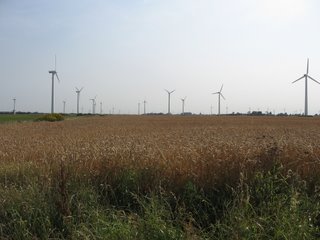 Wind turbines near Büsum
Wind turbines near BüsumThis evening we went for a walk to watch the sunset over the North Sea. As we said, we last paddled in the Adriatic. This evening we did so in the North Sea! There was a pleasure in seeing the sea again but it seems so very far away with just shallow mud full of cockles stretching away into the far distance. The sun though was glorious as it sank below the horizon. And jolly glad we were to see it go! At 10pm it is still 25 degrees but that feels really cool after the heat of the day.
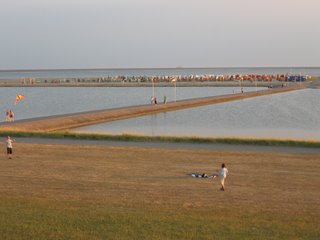 Our first view of the North Sea, Büsum
Our first view of the North Sea, Büsum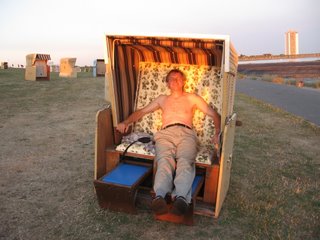 Who says the Germans always get the best places by the sea? Büsum
Who says the Germans always get the best places by the sea? Büsum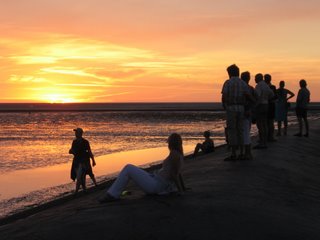 Watching the sun go down, Büsum
Watching the sun go down, BüsumThe number of showers on this site is quite inadequate. It's nearly midnight and Ian's just returned looking cool and clean so while he sorts out today's photos, I'm off to try my luck before the early morning rush arrives! At least at this time of the night moving around is reasonably comfortable.
Ian has just been speculating whether the town of Büsum should be twinned with Brest! Time for sleep before any more bright ideas occur to him.
Thursday 27th July 2006, Husum, on the North Sea, Schleswig-Holstein
This morning we woke in metaphysical mood to yet another day of dazzling sunlight. "Busy old fool, unruly Sun. Why must thou thus through windows and through curtains peer on us?"
At breakfast, where we cowered from the heat between the hedge and Modestine's flank, seeking shade, we were joined by a large hare! We are not accustomed to seeing them at such close quarters but it was driven to such tame behaviour by the desire for the few blades of grass next to the hedge not yet scorched the pale yellow of the Friesian countryside. Later, we saw a hare that had been hit by a passing car, lying dead on the roadside. As Ian said, still in metaphysical mood, "Hare today and gone tomorrow".
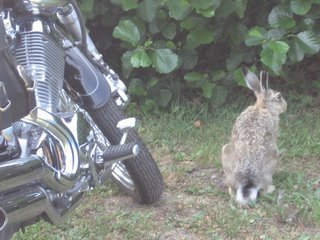 Hare today, Büsum
Hare today, BüsumThis morning we explored this area of North Friesland. Many place-names around here end in Koog which is the Friesian term for Polder. At the estuary of the river Eider a row of massive sluices has been constructed to limit the flow of water passing up and down during high tides or river floods. This proved a very interesting visit and explained a lot about how the area is gradually drained and reclaimed. Work on the flood prevention barrier – the Eidersperrwerk - was completed in 1973 after serious flooding in1962. It also provides a bridge that enables cars and bicycles to cross the estuary quickly and conveniently without the necessity of a five kilometre detour. While we were there the road was raised to permit a vessel to pass up the estuary and the iron sluice-gates came down to reduce the inward flow of the incoming tide. It is an impressive piece of engineering work and has greatly reduced storm and flood damage to crops and farmlands since its installation.
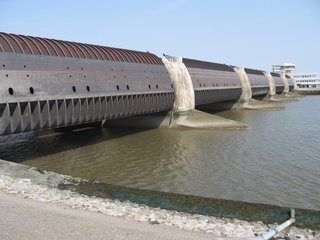 Sluice gates, Eidersperrwerk
Sluice gates, EidersperrwerkIt was very enjoyable for us to potter around on the muddy beach amidst the mussels and cockles at the water's edge, listening to the plaintive cry of the herring gulls, the sharp scream of the terns and the sounds of the estuary wading birds. There is a great pleasure in the familiar smells and sounds of Europe's more northern sea waters after so long on the soft sands of the Mediterranean. The most appreciated thing though, was the soft breeze that disguised just how hot it has been today.
We drove on to Sankt Peter Ording on Eiderstedt, a peninsula which was once an island but has now been joined to the mainland by reclamation of land. This is a small village with a number of houses typical of the area, built in red brick and often thatched. Having struggled through its pretty little streets in heat that made us both feel unwell, we took refuge in the cool of the church. This was a simple building with blue painted pews and an interesting locally carved 17th century wooden altar screen.
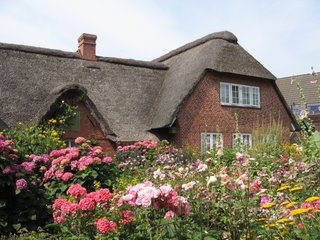 Cottage in Sankt Peter Ording
Cottage in Sankt Peter Ording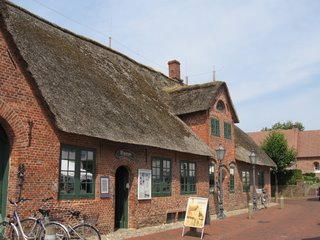 Traditional 18th century farmhouse, now a museum, Sankt Peter Ording
Traditional 18th century farmhouse, now a museum, Sankt Peter Ording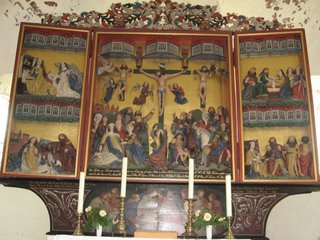 Reredos in the church, Sankt Peter Ording
Reredos in the church, Sankt Peter OrdingOur onward route carried us through a bleached landscape of crops and stubble. We passed a number of Haubarge - typical low farmhouses with massive thatched roofs, often set in clumps of trees for shelter. They stand isolated amidst the endless flat landscape, which is sometimes below sea level, with dykes providing protection from possible flooding from sea and rivers.
Our next stop was Friedrichstadt, founded by Dutch refugees on land granted by Duke Friedrich III of Holstein in 1621. This turned out to be a little corner of Holland! It was more Dutch than many typical towns to be found in Holland. There are canals and terraces of little brick houses with decorated gables. The market square is lined with large, tall buildings with mansard roofs and gables and the shops are straight from Delft with window displays of blue and white pottery, ceramic windmills and even clogs! For lunch we tried the typical local fare – Bismark herrings and onions in a roll with glasses of chilled water. We found the empty church where we sat exhausted as the cool air wrapped around us. Again the feel was very Dutch and there was an ornately decorated and carved 17th century pulpit in the church with inscriptions in Dutch.
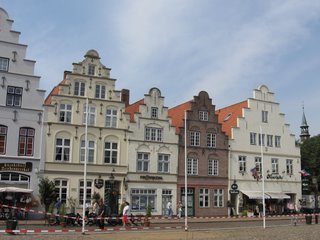 Gabled houses on the market square, Friedrichstadt
Gabled houses on the market square, Friedrichstadt Residential street, Friedrichstadt
Residential street, Friedrichstadt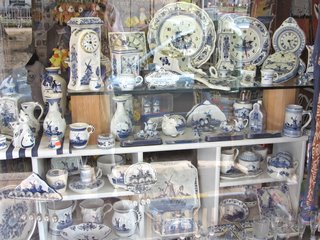 Shop window with Delft ceramics, Friedrichstadt
Shop window with Delft ceramics, FriedrichstadtIt was too uncomfortable to enjoy looking around. Given the choice we would not be doing any of this on such a day, but we have no choice. We are staying on flat treeless campsites without a speck of shade during the day where temperatures are up into the forties. We do not even have an awning for Modestine so we have to drive to get any breeze and take shelter wherever we can find it. So often the streets have no shade at all and we have taken to measuring the distance from one patch of shadow to the next before setting off, as fast as we can between the two points! It is the hardest and most difficult time we have had to cope with. No matter which direction we take from here, there does not look any likelihood of improvement. We do not know how we are going to survive the next few weeks. On the way back to Modestine we sat on the bank of the canal and soaked ourselves in water. Seconds later we were dry and as hot as ever.
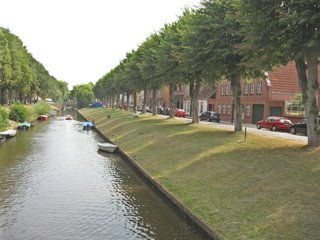 Canal in Friedrichstadt
Canal in FriedrichstadtAt Husum we eventually found an internet place. It felt like a sauna in there. It was expensive and we were unable to load the images we needed properly. It's the second time we have tried to load them for that particular blog. It is all so frustrating. Internet places are few and far between up here. It could be days before we have another opportunity.
We were too hot and sticky to explore the town but found a campsite nearby so can return tomorrow. It is nearly midnight and only now is the temperature becoming bearable. By 6am we will have started the next day of torment.
We do not wish to sound negative about the area of Friesland. We have just not been able to do it full justice and the last thing we feel like doing at night when it is so close is sorting out pictures and writing the blog. In cooler weather the area offers lots of interesting activities from sailing and canoeing to cycling, swimming, riding and sand yachting. There are numerous pretty villages and some beautiful rural churches. The vernacular architecture is picturesque and the landscape charged with character. High dykes protect the fields from the sea and the sparse yellow grass along the top is browsed by sheep, much as it is on the Marshes of Romney, Camber and Dymchurch.
It is sometimes difficult to believe we are still in Germany here in Schleswig-Holstein. It is so very different from either Bavaria, Saxony or any of the other states we have visited on our travels. It is right on the border with Denmark and the local diet certainly reflects this with restaurants selling all kinds of north sea fish, crabs and eels prepared in all sorts of ways – smoked, baked, pickled and raw. The buildings in the towns and villages look very Dutch while out in the countryside with its canals, reed beds, wheat fields, vegetable gardens full of cabbages and carrots and huge thatched farmsteads you can imagine yourself in Norfolk or Suffolk or indeed any of the low-lying counties of south eastern England.
